PALYNOFACIES ANALYSIS OF NAOKELEKAN
FORMATION, NORTHERN IRAQ
JAN ISAMEL
*, HÜKMÜ ORHAN
Department of Geological Engineering, Selçuk University, Konya, Turkey
Abstract. Palynofacies analysis of 38 rock samples of the Late Oxfordian-Early Kimmeridgian Naokelekan Formation from two exploratory wells and
two outcrops in northern Iraq was performed. All samples taken from
outcrops in Duhok and Sulaymaniyah provinces and well Bj-1 in northern Iraq were classified as palynofacies Type I (PF-1), which comprises mainly amorphous organic matter (AOM). The samples were deposited in a distal suboxic-anoxic basin and their organic matter (OM) is considered as Type II kerogen. Samples from well Jk-1 were interpreted as palynofacies Type II (PF-2) having mixed AOM and phytoclasts. These samples were deposited in
a distal dysoxic-anoxic shelf basin and their organic matter is classified as
Type II kerogen.
Keywords: palynofacies analysis, Naokelen Formation, amorphous organic matter, phytoclasts.
1. Introduction
The Naokelekan Formation, the type section of which is located 500 m from Naokelekan village in Rawnduz district of northern Iraq, was first described by Wetzel and Morton [1].
The Late Oxfordian-Early Kimmeridgian Naokelekan Formation com-prises black bituminous dolomite and fossiliferous limestone, interbedded bituminous shale and fine-grained limestone and laminated bituminous lime-stone. It crops out at Duhok Naokelekan, Barsarine and Sulaymaniyah provinces. In addition, the Naokelekan Formation has been described in some of the oil wells in northern Iraq.
Palynofacies analysis has been widely used in petroleum geology for determining the origin of organic matter (OM) in sedimentary rocks to identify the composition and abundance of its different types, as well as the deposition of source rocks [2].
With this study, it is aimed to better understand the paleoenvironment and depositional conditions of the Naokelekan Formation, one of the source rocks for the oil reservoirs in Iraq, sampled from two oil wells and two out-crops in northern Iraq.
2. Study area
The current study focuses on two surface outcrops of the Naokelekan Formation and two wells in northern Iraq (Fig. 1). Both outcrop sections are located in the High Folded Zone; the Sargelu area is in Sargelu village near Surdash town (latitude: 35° 52ʹ 44ʺ N and longitude: 45° 09ʹ 25ʺ E) and the Banic area is about 500 m from Banic village in Duhok province (latitude: 37° 13ʹ 33.4ʺ N and longitude: 42° 58ʹ 2.6ʺ E). The locations of the sampled oil wells are: (i) Jk-1 at Jabal Kand village (latitude: 40°.59ꞌ.488ʺ N and longitude: 32°.36ꞌ.62ʺ E) and (ii) Bj-1 at Bijii village (latitude: 38°.5132ꞌ.981ʺ N and longitude: 34°.8078ꞌ.747ʺ E).
Fig. 1. Location map of the sampling sites in northern Iraq.
3. Geological setting
The study area is located in the northwestern part of the Zagros fold-thrust belt in northeastern Iraq, which represents the deformed northeastern margin
of the Arabian plate. Tectonically, Iraq lies in the border area between the Arabian part of the African (Nubio-Arabian) Platform and the Asian branches of the Alpine geosyncline. The platform of Iraqi territory is divided into two basic units: the Stable Shelf and the Unstable Shelf. The Stable Shelf is characterized by a reduced thickness of sedimentary cover and the lack of folding. The Unstable Shelf has a thick and folded sedimentary cover [3].
Stratigraphically, the High Folded and Balambo-Tanjero Zones are characterized by a condensed thin sedimentary euxinic succession characteristic of the lower part (Naokelekan Formation), and a lagoona1 evaporitic succession typical of the upper part (Barsarin Formation). This caused the researchers to assume that there was a tectonic ridge present in northern Iraq, which isolated this region from the country’s southern part [4]. In northern Iraq, the Naokelekan Formation has outcrops in Duhok and Sulaymaniyah provinces. The Late Oxfordian-Early Kimmeridgian Naokelekan Formation comprises black bituminous dolomite and fossiliferous limestone, with thin bedded bituminous shale interbeds in the bottom part, and interbedded bituminous shale fine-grained limestone and laminated bituminous limestone in the upper part (Fig. 2a–c). In the outcrop the
(a) (b)
(c) (d)
Fig. 2. Pictures of outcrops in the Naokelekan Formation: a) mottled fossiliferous limestone lithofacies in the upper part of the formation (core Surdash anticline); b) general view of the formation (core Surdash anticline); c) lower part of the formation in the Banic area; d) general view of the formation in the Banic area.
formation can be distinguished by its upper part which is composed of mottled limestone lithofacies (Fig. 2d).
The Naokelekan Formation crops out in the High Folded Zone in the Banic area and is exposed within the Surdash anticline near Sargelu village in the Sargelu area.
The Naokelekan Formation overlies the Callovian-Toarcian Sargelu Formation and conformably underlies the Late Oxfordian-Kimmeridgian Barsarine Formation (Fig. 3). In the formation, Hibolites semihastatus (Blainville), Kurnubia palestiniensis Henson, Ammobaculites sp., Textulariidae, Nautiloculina oolithica Mohler, Protoglobigerina sp., the algae Cladocoropsis thaumatoporella sp., Cayeuxia doerflesiana, Cadosina sp. Dasycladacea and Stromatoporoid shuqraia heybrocki have been defined, and the depositional environment has been interpreted as an euxinic environment in a very slightly or subsiding or starved basin [5].
4. Materials and methods
A total of 38 samples were collected from the Late Oxfordian-Early Kimmeridgian Naokelekan Formation, 17 samples from well cuttings (11 samples from well Bj-1 and 6 from well Jk) and 21 samples from two outcrops (18 samples from the Sargelu area, 3 samples from the Banic area).
Slides for palynofacies analysis were prepared at the Geology Depart-ment, Faculty of Science, Mansoura University, Egypt by following the standard preparation techniques. Significant variations in palynofacies character can only be assessed by a proper counting and analysis of the numerical data [6]. In order to quantify the relative amount of particulate organic matter, at least 200 particles larger than 10 µm were counted in each sample [2]. The counting was carried out under 40x magnification.
The different categories of total particulate organic matter defined in the samples, as well as their biological sources, constituents and kerogen type are presented in Table 1. The main organic constituents are illustrated in Plates I and II. The relative frequencies of occurrence (%) of palynomorphs, phytoclasts and amorphous organic matter (AOM) counted on a total of 200 particles are given Tables 2 and 3.
Table 1. Categories of total particulate organic matter defined in the samples from the Naokelekan Formation, northern Iraq, and their biological sources, constituents and kerogen type (modified from [6])
Category Biological source Constituent Pure kerogen type Zoomorphs Foraminiferal linings Scolecodonts Gas-prone III Palynomorphs
Organic-walled
phytoplankton Dinocysts Oil-prone II Cuticle
Cortex tissues Wood
III Gas-prone Phytoclasts Macrophyte plant debris
Charcoal Inert IV AOM Phytoplankton Organic aggregates and fecal pellets Oil-prone II AOM – amorphous organic matter.
4.1. Definition and classification of palynofacies
The term “palynofacies” was first introduced by Combaz [7] to include all types of acid-resistant organic matter retrieved from a sediment or sedi-mentary rock by palynological processing techniques. The composition and occurrence of OM in sedimentary rocks reflect most of the variables that affect the terrestrial or aquatic environments in which it was generated, transported and deposited [8].
According to Tyson [2], the main objective of microscopic investigation of palynofacies is to determine the origin, hydrocarbon-generating potential and degree of thermal alteration of OM, the relative percentages and pre-servation state of its different constituents, as well as the nature of the depositional paleoenvironment and the oxidation-reduction conditions.
The three main groups of morphologic constituents recognized within the kerogen assemblage are: palynomorphs (organic-walled constituents that remain after maceration using HCl and HF acids), phytoclasts (fragments of tissues derived from higher plants or fungi) and amorphous organic matter (structureless material derived from non-fossilizing algae, or advanced tissue biodegradation, phytoplankton or bacterially derived AOM, higher plants resins and amorphous products of the diagenesis of macrophyte tissues) [2].
According to Thompson and Dembicki [9], four recurring types of amorphous kerogen are optically identified in petroleum source rock samples and are related to hydrocarbon-generating potential (defined here as geo-chemically interpreted “oil-prone” or “gas-prone”). The different amorphous kerogen types are distinguished on the basis of microscopic textural differences. Type A contains chunky compact masses with mottled network or weak polygonal textures, Type B is composed of very small, dense,
elongate, oval or rounded individual grains, Type C consists of clumps with granular, fragmented or globular textures, and Type D is composed of thin, platy or rectangular individual grains.
Geochemically defined oil-prone samples generally contain types A and/or D separately or combined, geochemically defined gas-prone samples rarely contain Type A and vary in amounts of Types B, C and/or D.
Table 2. Distribution of the palynodebris and percentages of the different types of organic matter in the samples from the Naokelekan Formation in Duhok (Banic area) and Sulaymaniyah (Sargelu area) provinces, northern Iraq
Organic matter, %
Sample no. Area Sample type Age Formation Lithology Palynofacie
s
AOM Phytoclasts Palynomorph
s 1 99 1 0 2 Shale 99 1 0 3 95 3 2 4 96 4 0 5 97 2 1 6 96 2 2 7 92 5 3 8 93 5 2 9 93 4 3 10 95 3 2 11 94 4 2 12 Shaly limestone 95 3 2 13 96 3 1 14 Shale 94 4 2 15 92 6 2 16 93 5 2 17 89 9 2 18 Sulaymaniyah province Shaly limestone 92 6 2 1 94 1 5 3 98 0 2 5 Duhok province Su rface s amples Late Oxfordian- Early Kimmeridgian Naokelekan Shaly limestone PF-1 97 0 3 AOM – amorphous organic matter.
Table 3. Distribution of the palynodebris and percentages of the different types of organic matter in the samples from the Naokelekan Formation, wells Bj-1and Jk-1, northern Iraq
Organic matter, %
Sample no. Well Depth, m Sample type Age Formation Lithology Palynofacies AOM Phytoclasts Palynomorphs
1 2049 55 38 7 2 2051 Shaly limestone 60 32 8 3 2061 Shale 64 28 8 4 2069 64 31 5 5 2081 71 34 5 6 Jk-1 2090 Shaly limestone PF-2 70 36 4 7 2392 91 5 4 8 2393 95 4 1 9 2401 Shaly limestone 94 4 2 10 2403 96 4 0 11 2404 96 3 1 12 2405 98 2 0 13 2406 99 1 0 14 2407 97 2 1 15 2408 97 2 1 16 2409 96 3 1 17 Bj-1 2411 Cutting
Late Oxfordian-Early Kimmeridgian
Naokelekan
Shale
PF-1
96 2 2 AOM – amorphous organic matter.
5. Results and discussion
The data provided here is based on cuttings samples from hydrocarbon exploration wells Bj-1 and Jk-1 and hand samples from Sargelu and Banic areas(Figs. 4, 5, 6).
Based on the quantitative and qualitative variations in the kerogen content and the distribution of amorphous organic matter vs phytoclasts and palynomorphs, two main types of palynofacies linked to depositional paleo-environmental variations are recognized and will be described below.
5.1. Palynofacies Type 1
Type 1 palynofacies (PF-1) was determined on the basis of the relatively high proportion of organically formed amorphous organic matter, with a very small proportion of plant forms and life forms.
Fi
Fig. 4 . Percent ages of part ic ul at e or gani c mat te r i n th e samp les fro m th e Nao ke lek an Fo rmatio n, Duhok (Banic area) an d Sulaymaniyah (Sar
gelu area) provinces
and wel ls B j-1 and Jk-1 i n nort hern Iraq. (The abbrevi at ion used: AOM – amorphous or gani c mat te r.)
Fig. 5. APP ternary diagram for samples from wells Bj-1 and Jk-1 in Duhok (Banic area) and Sulaymaniyah(Sargelu area) provinces [6].
The amorphous organic matter of 11 subsurface samples from the Naokelekan Formation from well Bj-1 (Table 3), as well as of all 21 samples from outcrops in Sulaymaniyah and Duhok provinces (Table 2) was defined as Type 1 palynofacies.
In well Bj-1, this facies appeared clearly at depths between 2392 and 2411 m, achieving the highest percentage (99%) at a depth of 2406 m and 94% at a depth of 2401 m, with an average of 97% (Table 2). Classified as Type A and Type D by Thompson and Dimbicki [9], the amorphous organic matter in these facies is brown to reddish brown in color and was interpreted as “oil-prone”. The amorphous organic matter of associated Types C and D is dark brown in color and is gas-prone (Plate I, 3–4). The OM in this facies was considered as Type II kerogen [9].
Fig. 6. APP ternary diagram for samples from wells Bj-1 and Jk-1 [6]. In the Sulaymaniyah province, 18 samples, one at each meter of the 18 m thick Naokelekan Formation, were analyzed (Table 2). The AOM is repre-sented by three types, from top to bottom: Type A, Type B and Type C [9]. The color of the three types varies from brown to dark brown (Plate II, 5–7). The organic matter was classified mainly as Type II kerogen and, to a lesser extent, as Type III kerogen.
In the Banic area, three samples were collected at 1, 3, 5 meters from the 7 m thick Naokelekan Formation (Table 2). The amorphous organic matter is represented by yellowish-brown and oil-prone Type A, dark brown, oil- and gas-prone Type B and Type C [9] (Plate II, 5). It comprises mainly Type II kerogen with little Type III.
The section comprising phytoclasts within this facies appears in well Bj-1 at a depth of 2392 m as pieces of plant leaves (Plate II, 1) and at a depth of
2403 m as pieces of plant (Plate II, 2). In the Sargelu area it appears at 13 meters from the base of the Naokelekan Formation as plant leaves (Plate II, 3), and in the Banic area at 1 meter from the base as pieces of plant leaves (Plate II, 4).
The palynomorphs were determined within this facies in well Bj-1 at a depth of 2393 m as caved material, spore and pollen (Plate II, 7), and at a depth of 2401 m as fungal spore (Plate II, 8). In the Sargelu area, they were observed at 7 meters from the base of the Naokelekan Formation as caved material (Plate II, 9), as well as at 9 meters as dinoflagellate crystals (Plate II, 10).
5.2. Palynofacies Type 2
Type 2 palynofacies (PF-2) was distinguished from PF-1 by its high proportion of plant forms. It was defined only in six samples from well Jk-1 (Table 4), at depths between 2049 and 2090 m, with the highest percentage of AOM (64%) at a depth of 2069 m, and the lowest percentage (55%) at a depth of 2049 m, with an average of 60%. The brown to reddish brown amorphous organic matter was classified as Type A and Type B, according to Thompson and Dembicki [9] (Plate I, 11–12).
The palynomorphs were determined within this facies in well Jk-1, with the highest percentage of phytoclasts (38%) at a depth of 2049 m, and the lowest percentage (28%) at a depth of 2061 m (Plate II, 5–6, 11–12).
In this work, the ternary diagram introduced by Tyson [2] was used to illustrate a clear distinction between amorphous organic matter, phytoclasts and palynomorphs (APP). Tyson [2] used this diagram for characterizing the kerogen assemblages and for discerning the differences in relative proximity to terrestrial organic matter sources, kerogen transport paths and the redox status of the depositional subenvironments that control AOM preservation.
The data plotted on the APP ternary diagram indicate two main types of palynofacies (Figs. 5 and 6).
Palynofacies Type 1 is characterized by amorphous organic matter com-prising resins and structured and unstructured AOM. The high percentage of AOM resulted from good
preservation rates and low-energy environments. The preservation of AOM in the studied samples is indicative of dysoxic-anoxic deposition conditions [6]. The samples of PF-1 from Duhok (Banic area) and Sulaymaniyah (Sargelu area) provinces and well Bj-1 lie mainly in the field IX on the APP diagram (Fig. 6) [6], which reflects a distal suboxic-anoxic basin, and organic matter is also classified as Type II > I kerogen, which is highly oil-prone [2].The samples of PF-2 from well Jk-1 are scattered in the field VII on the APP diagram and are interpreted as having been deposited in a distal dysoxic-anoxic shelf environment, and the organic matter is classified as Type II kerogen, which is oil-prone [2] (Fig. 6, Table 3).
6. Conclusions
The Naokelekan Formation is one of the source rocks in northern Iraq. It is represented by black bituminous dolomite and fossiliferous limestone, with thin bedded bituminous shale interbeds in the bottom part and interbedded bituminous shale fine-grained limestone and laminated bituminous limestone in the upper part.
The palynofacies analysis of the Naokelekan Formation distinguishes two distinct types of palynofacies – Palynofacies Type 1 (PF-1) and Palynofacies Type 2 (PF-2).
PF-1 facies is characterized by a high proportion of amorphous organic matter with some amount of phytoclasts and palynomorphs, which is con-sidered as Type II kerogen. On the amorphous organic matter-phytoclasts-palynomorphs diagram, the depositional environment of this facies is interpreted as a distal suboxic-anoxic basin. PF-2 facies is represented by a mixture of amorphous organic matter and phytoclasts, which is interpreted as Type II kerogen. According to the amorphous organic matter-phytoclasts-polymorphs diagram, this facies is deposited in a distaldysoxic-anoxic shelf basin.
Acknowledgements
The authors are grateful to the Selçuk University Research Fund for financial support (Project No. 16201040), to the North Oil Company in Iraq for supplying well samples, and special thanks belong to Mr. Adel Ferman, Lecturer in Kirkuk University, for his logistic support.
Plate I
Subfigures:
1 – AOM, well Bj-1, classified as Type-A palynofacies. 2 – AOM, well Bj-1, classified as Type D palynofacies. 3 – AOM, well Bj-1, classified as Type B palynofacies. 4 – AOM, well Bj-1, classified as Type C palynofacies.
5 – AOM, Sulaymaniyah province (Sargelu area), classified as Type A palynofacies.
6 – AOM, Sulaymaniyah province (Sargelu area), classified as Type A palynofacies.
7 – AOM, Sulaymaniyah province (Sargelu area), classified as Type C palynofacies.
8 – AOM, Duhok province (Banic area), classified as Type A palynofacies. 9 – AOM, Duhok province (Banic area), classified as Type C, palynofacies. 10 – AOM, Duhok province (Banic area), classified as Type B palynofacies. 11 – AOM, well Jk-1, classified as Type A palynofacies.
12 – AOM, well Jk-1, classified as Type B palynofacies. The abbreviation used: AOM – amorphous organic matter.
Plate II
Subfigures:
1 – Phytoclast, well Bj-1, plant leaves at a depth of 2392 m. 2 – Phytoclast, well Bj-1, plant pieces at a depth of 2403 m.
3 – Phytoclast, Sulaymaniyah province (Sargelu area), plant leaves at a depth of 13 m.
4 – Phytoclast, Duhok province (Banic area), plant leaves at a depth of 1 m. 5 – Phytoclast, well Jk-1, plant leaves.
6 – Phytoclast, well Jk-1, plant pieces.
7 – Palynomorph, well Bj-1, caved material at a depth of 2392 m. 8 – Palynomorph, well Bj-1, fungal spore at a depth of 2401 m.
9 – Palynomorph, Sulaymaniyah province (Sargelu area), caved material at a depth of 7 m.
10 – Palynomorph, Sulaymaniyah province (Sargelu area), dinoflagellate crystals at a depth of 9 m.
11 – Palynomorph, well Jk-1, consists of dinoflagellate crystals. 12 – Palynomorph, well Jk-1, consists of spores
.
REFERENCES
1. Wetzel. R., Morton, D. M. Naokelekan Formation. In: Lexique Stratigraphic International (Bellen, R. C. van, Dunnington, H. V., Wetzel, R., Morton, D.M., eds.), Vol. III, Asia, Fascicule 10, Iraq. Paris, 1950, 211–215 (in French). 2. Tyson, R. V. Sedimentary Organic Matter. Organic Facies and Palynofacies.
Chapman and Hall, London, 1995, 615 pp.
3. Buday, T. The Regional Geology of Iraq: Stratigraphy and Paleogeography, Vol. 1. Dar Al-Kutub Publishing House, University of Mosul, Mosul, Iraq, 1980, 445 pp.
4. Jassim, S. Z., Buday, T. Tectonic Framework. In: Geology of Iraq (Jassim, S. Z, Goff, J. C., eds). Dolin, Prague and Moravian Museum (Brno), Czech Republic, 2006, 45–55
5. Jassim, S. Z., Goff, J. C. Geology of Iraq. Dolin, Brno, Prague and Moravian Museum, 2006, 352 pp.
6. Tyson, R. V. Palynofacies analysis. In: Applied Micropaleontology (Jenkins, D. G., ed.). Kluwer Academic Publishers, The Netherlands, Amster-dam, 1993, 153–191.
7. Combaz, A. Les palynofaciès. Revue de Micropalèontologie, 1964, 7(3), 205– 218 (in French).
8. Batten, D. J. Palynofacies and paleoenvironmental interpretation. In: Palyno-logy: Principles and Applications (Jansonius, J., McGregor, D. C., eds.), Vol. 3. American Association of Stratigraphic Palynologists Foundation, College Station, TX, 1996, 1011–1064.
9. Thompson, C. L., Dembicki Jr., H. Optical characteristics of amorphous kerogens and the hydrocarbon-generating potential of source rocks. Int. J. Coal Geol., 1986, 6(3), 229–249.
Presented by M. Pensa Received January 29, 2018
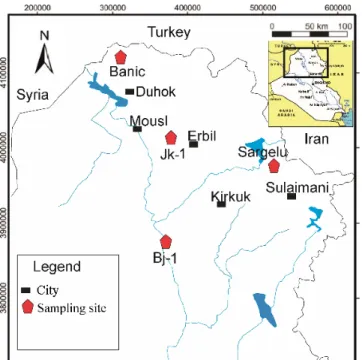
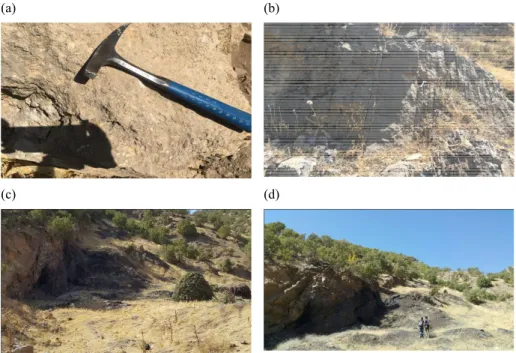
![Fig. 3. Lithostratigraphic column of the Jurassic-Cretaceous formations studied [5].](https://thumb-eu.123doks.com/thumbv2/9libnet/4985364.101185/5.892.256.642.192.1024/fig-lithostratigraphic-column-jurassic-cretaceous-formations-studied.webp)
![Table 1. Categories of total particulate organic matter defined in the samples from the Naokelekan Formation, northern Iraq, and their biological sources, constituents and kerogen type (modified from [6])](https://thumb-eu.123doks.com/thumbv2/9libnet/4985364.101185/6.892.193.700.264.481/categories-particulate-naokelekan-formation-northern-biological-constituents-modified.webp)
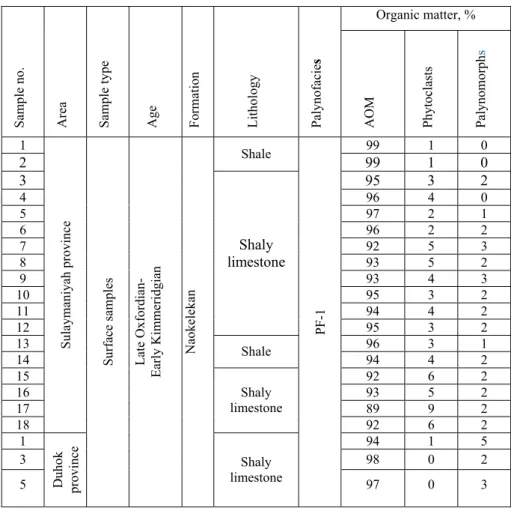
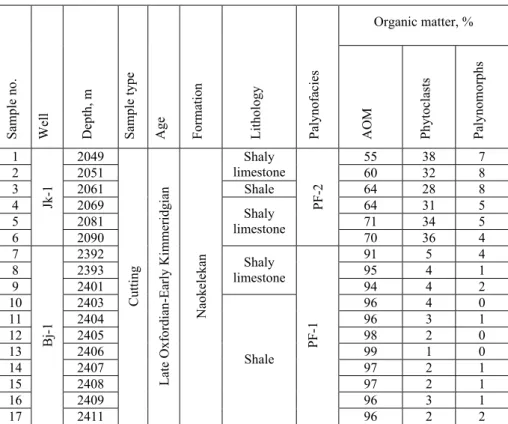
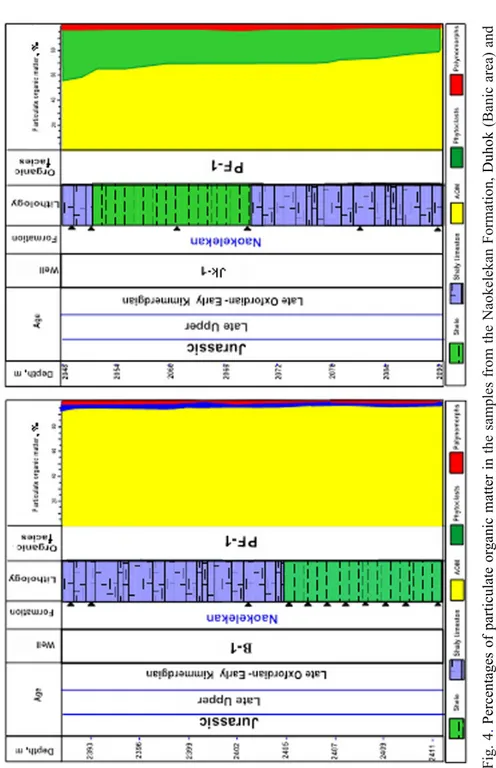
![Fig. 5. APP ternary diagram for samples from wells Bj-1 and Jk-1 in Duhok (Banic area) and Sulaymaniyah (Sargelu area) provinces [6]](https://thumb-eu.123doks.com/thumbv2/9libnet/4985364.101185/11.892.201.693.190.722/ternary-diagram-samples-duhok-banic-sulaymaniyah-sargelu-provinces.webp)
![Fig. 6. APP ternary diagram for samples from wells Bj-1 and Jk-1 [6].](https://thumb-eu.123doks.com/thumbv2/9libnet/4985364.101185/12.892.200.696.190.746/fig-app-ternary-diagram-samples-wells-bj-jk.webp)